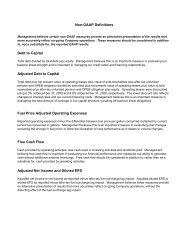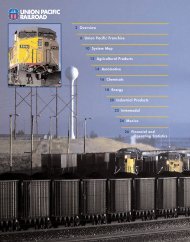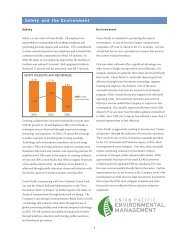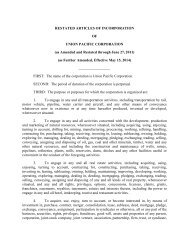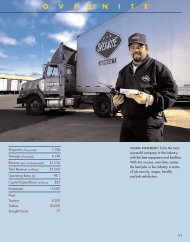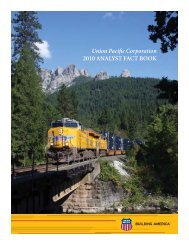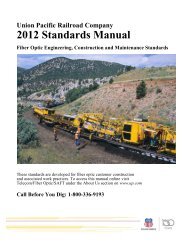Form 10-K - Union Pacific
Form 10-K - Union Pacific
Form 10-K - Union Pacific
Create successful ePaper yourself
Turn your PDF publications into a flip-book with our unique Google optimized e-Paper software.
are allocated using appropriate statistical bases. Total expense for repairs and maintenance incurred was<br />
$2.2 billion for 2011, $2.0 billion for 20<strong>10</strong>, and $1.9 billion for 2009.<br />
Assets held under capital leases are recorded at the lower of the net present value of the minimum lease<br />
payments or the fair value of the leased asset at the inception of the lease. Amortization expense is<br />
computed using the straight-line method over the shorter of the estimated useful lives of the assets or the<br />
period of the related lease.<br />
12. Accounts Payable and Other Current Liabilities<br />
Dec. 31, Dec. 31,<br />
Millions 2011 20<strong>10</strong><br />
Accounts payable $ 819 $ 677<br />
Income and other taxes 482 337<br />
Accrued wages and vacation 363 357<br />
Dividends payable 284 183<br />
Accrued casualty costs 249 325<br />
Interest payable 197 200<br />
Equipment rents payable 90 86<br />
Other 624 548<br />
Total accounts payable and other current liabilities $ 3,<strong>10</strong>8 $ 2,713<br />
13. Financial Instruments<br />
Strategy and Risk – We may use derivative financial instruments in limited instances for other than<br />
trading purposes to assist in managing our overall exposure to fluctuations in interest rates and fuel<br />
prices. We are not a party to leveraged derivatives and, by policy, do not use derivative financial<br />
instruments for speculative purposes. Derivative financial instruments qualifying for hedge accounting<br />
must maintain a specified level of effectiveness between the hedging instrument and the item being<br />
hedged, both at inception and throughout the hedged period. We formally document the nature and<br />
relationships between the hedging instruments and hedged items at inception, as well as our riskmanagement<br />
objectives, strategies for undertaking the various hedge transactions, and method of<br />
assessing hedge effectiveness. Changes in the fair market value of derivative financial instruments that<br />
do not qualify for hedge accounting are charged to earnings. We may use swaps, collars, futures, and/or<br />
forward contracts to mitigate the risk of adverse movements in interest rates and fuel prices; however, the<br />
use of these derivative financial instruments may limit future benefits from favorable interest rate and fuel<br />
price movements.<br />
Market and Credit Risk – We address market risk related to derivative financial instruments by selecting<br />
instruments with value fluctuations that highly correlate with the underlying hedged item. We manage<br />
credit risk related to derivative financial instruments, which is minimal, by requiring high credit standards<br />
for counterparties and periodic settlements. At December 31, 2011 and 20<strong>10</strong>, we were not required to<br />
provide collateral, nor had we received collateral, relating to our hedging activities.<br />
Determination of Fair Value – We determine the fair values of our derivative financial instrument<br />
positions based upon current fair values as quoted by recognized dealers or the present value of<br />
expected future cash flows.<br />
Interest Rate Fair Value Hedges – We manage our overall exposure to fluctuations in interest rates by<br />
adjusting the proportion of fixed and floating rate debt instruments within our debt portfolio over a given<br />
period. We generally manage the mix of fixed and floating rate debt through the issuance of targeted<br />
amounts of each as debt matures or as we require incremental borrowings. We employ derivatives,<br />
primarily swaps, as one of the tools to obtain the targeted mix. In addition, we also obtain flexibility in<br />
managing interest costs and the interest rate mix within our debt portfolio by evaluating the issuance of<br />
and managing outstanding callable fixed-rate debt securities.<br />
Swaps allow us to convert debt from fixed rates to variable rates and thereby hedge the risk of changes in<br />
the debt’s fair value attributable to the changes in interest rates. We account for swaps as fair value<br />
76



